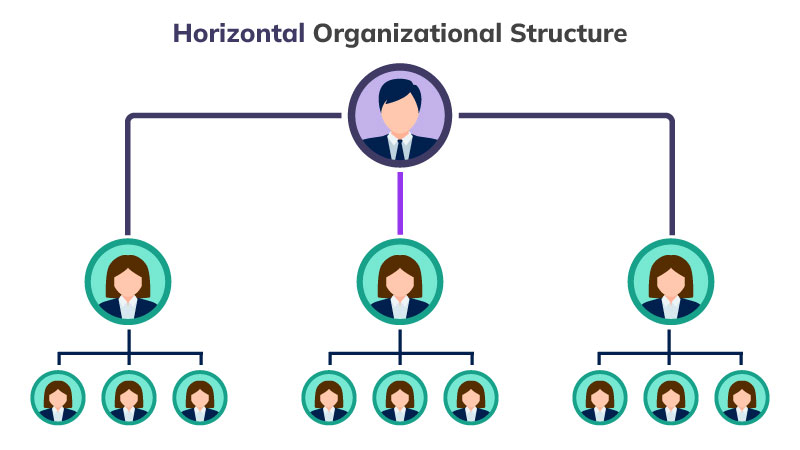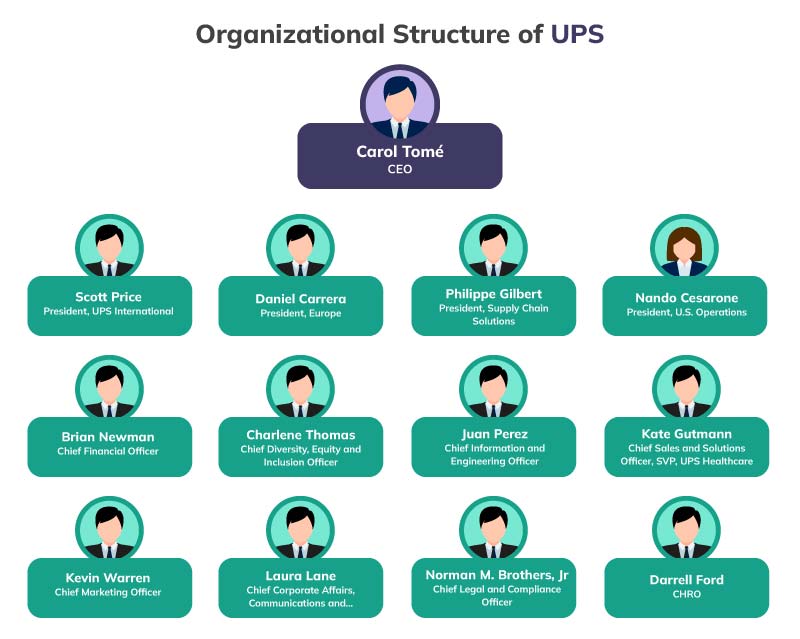Introduction to Horizontal Organizational Structure
The meaning of horizontal is going from side to side and not up and down. A horizontal organizational structure is just like the flat management structure that involves a few hierarchical levels and a short chain of command. The organization that follows a horizontal organizational structure has few managers in the organization which allows the employees to make various decisions without taking managerial approval. The horizontal structure involves only 2 to 3 chains of command with the owner working at the top level, managers and the leaders at the middle level, and the remaining employees below one layer of managers and team leaders.

Table of Contents
The horizontal organizational structure is mainly used by start-ups to build employee engagement and collaboration. Moreover, the presence of few managers and a large number of employees working under each manager also makes this organizational structure more suitable. However, some large organizations also adopt this organizational structure as it helps to encourage less supervision and higher employee engagement and involvement.
Advantages of Horizontal Organizational Structure
The horizontal organizational structure offers several benefits to the organizations by providing greater control to the employees and ensuring faster communication and decision-making. The key advantages of this organizational structure are discussed as follows-
Employee engagement- One of the main benefits of the horizontal organizational structure is that the horizontal organizational structure provides greater control and autonomy to employees over their roles due to fewer hierarchical levels which help to improve employee freedom and job satisfaction.
Optimum use of resources- The horizontal organizational structure enables optimum use of resources within the organization as the departments are not siloed in this type of organizational structure and each department works collaboratively to achieve the organizational objectives. The chance of duplication of the resources is also minimal in the horizontal organizational structure as each employee or manager can easily access the resources of another department.
Flexibility- The level of flexibility in the organization depends on the level of hierarchies and in the horizontal organizational structure, there is higher flexibility and coordination in the teams as a result of few hierarchies. The horizontal organizational structure also helps to facilitate faster communication and decision-making which helps employees to share ideas and implement various innovations in the organization.
Disadvantages of Horizontal Organizational Structure
While the horizontal organizational structure offers several benefits, it is not always the best organizational structure for each company. Lack of hierarchies within the organization can also lead to a decline in organizational productivity. Some of the disadvantages of the horizontal organizational structure are discussed as follows-
Decline in productivity- The horizontal organizational structure can lead to a decline in the productivity of the organization due to a lack of an effective control mechanism. Moreover, the horizontal organizational structure also discourages specialization within the organization and lack of engagement of experts can further result in a decline in the productivity of the organization.
Role ambiguity- Role ambiguity can be defined as the lack of clarity of roles among the employees regarding their roles and responsibilities. Although horizontal organizational structure provides autonomy to employees, it also leads to the problem of role ambiguity due to a greater degree of freedom to the employees and lack of clear supervision from the managerial roles.
Managerial issues- In the horizontal organizational structure, there is only one middle management layer and the managers are responsible to supervise a large number of employees working under them. This results in higher responsibility upon the managers in the horizontal organizational structure as compared to the vertical and tall organizational structure.
Example of Centralized Organizational Structure
United Parcel Service (UPS) adopts the horizontal organizational structure as there are few hierarchies in the UPS organizational structure. There is a wider span of control in UPS and a short chain of command. The organizational structure of UPS is represented as follows-

The organizational chart of UPS represents that Carol Tome sits at the top of the hierarchy of UPS and all the managers and leaders at UPS are required to report to the CEO only. There is only one layer of management at UPS which helps to facilitate direct communication between managers and employees. The employees working under each managerial head are also provided a greater degree of autonomy in the operations. Hence, the relaxed structure of working is adopted at UPS to encourage collaboration and teamwork. This also helps to make employees feel empowered in the organization which helps to improve the organization’s productivity through higher employee engagement.
FAQs
When is a Horizontal Organizational Structure suitable?
A horizontal structure is suitable for organizations that value collaboration, innovation, and agility. It is often seen in startups, creative industries, and organizations that require quick responses to dynamic market conditions.
Can a Horizontal Organizational Structure work for large corporations?
While horizontal structures are more common in smaller organizations, large corporations can also adopt elements of a horizontal approach in specific departments or for specific projects. Implementing horizontal practices can foster innovation and improve employee engagement.
Previous Structure
Hierarchical Organizational StructureNext Structure
Vertical Organizational Structure
 Proof Reading
Proof Reading  Copy Writing
Copy Writing  Resume Writing
Resume Writing  Blogs
Blogs Guides
Guides SOP's
SOP's Student Resources
Student Resources Research Topics
Research Topics Login
Login Register
Register